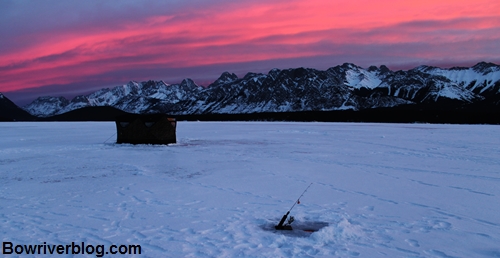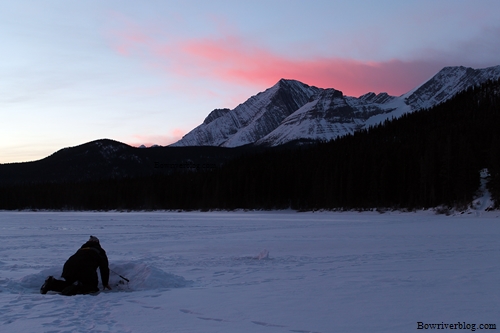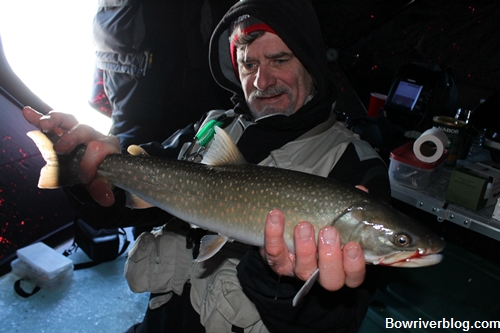The Mountains Are Calling
Escaping the concrete jungle of the city of Calgary was a much needed stress relief, it has been several months since I was able to leave the noise and pollution of the city behind and head for peace and serenity the mountains of Peter Lougheed Provincial Park offer. Clean air combined with peace and quiet was just what I needed after a crazy busy Christmas season. I don’t often fish the ice but I could not pass up the opportunity to try my skills on a willing Bull Trout who was hungry for some hardware. I have been to the Lower Kananaskis Lakes many times in the summer months and have even docked a friend’s boat on an island and slept there overnight, but never drilled holes in the black ice and jigged Buzz Bombs and or spoons for willing fish.
The Canadian Rockies are a major tourist destination with many coming from Asia and Europe to hike, cross country ski, downhill ski, mountain bike and fish. According to Wikipedia “the Canadian Rockies comprise the Canadian segment of the North American Rocky Mountains. They are the eastern part of the Canadian Cordillera, which is a system of multiple ranges of mountains which runs from the Canadian Prairies to the Pacific Coast. The Canadian Rockies mountain system comprises the southeastern part of this system, laying between the Interior Plains of Alberta and Northeastern British Columbia on the east to the Rocky Mountain Trench of BC on the west. The southern end borders Idaho and Montana of the USA. In geographic terms the boundary is at the Canada/US border, but in geological terms it might be considered to be at Marias Pass in northern Montana. The northern end is at the Liard River in northern British Columbia.
The Canadian Rockies have numerous high peaks and ranges, such as Mount Robson (3,954 m (12,972ft) and Mount Columbia (3,747M (12,293ft). The Canadian Rockies are composed of shale and limestone. Much of the range is protected by national and provincial parks, several of which collectively comprise a World Heritage Site”.
Lower Kananaskis Lake is a natural lake that was turned into a reservoir in Kananaskis Country in Alberta, Canada. Lower Kananaskis Lake lies against the steep slopes of Mount Indefatigable. The Kananaskis Lakes are beautiful, clear lakes in a striking setting of towering, ice-capped mountains. Located along the continental divide, there are numerous peaks over 3,000 m, many with glaciers, within 10 km of the lakes. The area can be reached from the city of Calgary by travelling 80 km west on Highway 1, then 56 km south on Highway 40 to Peter Lougheed Provincial Park, which includes the lakes.
Most inflow enters Lower Kananaskis Lake from Upper Kananaskis Lake via Interlake’s Power Plant. Boulton, Gypsum and Smith-Dorrien creeks also enter the lake. The watershed of Smith-Dorrien Creek was diminished in 1959 when two tributaries, French and Burstall creeks, were diverted out of the Kananaskis basin into the Spray Reservoir basin. Kent Creek was diverted in 1956 so it now flows into the lower lake rather than into the Kananaskis River downstream from the lakes. The Kananaskis power plants are used for winter “peak-power production” to supply electricity during times of the day when demand is highest, that is, early morning and evening. Therefore, water is released twice a day, resulting in a large daily variation in the flow of the Kananaskis River downstream. Some water is released from the lakes into the Kananaskis River from April to October; the amount depends on runoff, snowpack and demand for power generation.
The Kananaskis River was named by Captain Palliser in 1858 for an Indian, Joseph Kin-oh-ah-kis. A legend tells that it was at the confluence of the Kananaskis and Bow rivers that Kin-oh-ah-kis displayed supernatural powers upon regaining consciousness and recovering from an axe blow to the head (Appleby 1975). Coincidentally, the Stoney word Kin-oh-ah-kis means “meeting of the waters” (Finlay and Finlay 1987). The Kananaskis Lakes are near the Kananaskis River’s headwaters and were named after the river. The valley was used occasionally by Sarcee and Stoney Indians; in 1845, when the first white man, James Sinclair, traversed the valley, only a small group of Indians lived in the area. Sinclair came with 15 white families in Red River carts and 250 head of horses and cattle. They were accompanied by 100 Cree warriors for protection from attacks by the Blackfoot, but the Cree deserted the group near Morley. The group’s guide, the Cree chief Macipictoon stayed with the settlers. Difficult terrain forced them to abandon their carts near the Kananaskis Lakes. Continuing on foot over Kananaskis Pass, they eventually made it to the State of Washington. All of the settlers survived the trek, as did most of the livestock. Trappers later came to the area; one of these, George Pocaterra, built a cabin not far from the lakes in 1906. Pocaterra Creek and Pocaterra Dam were named after him.
After the railway came through the Bow Valley in 1883, logging began in the Kananaskis Valley. The Eau Claire and Bow River Lumber Company established a logging camp at the site of the present Eau Claire Campground (15 km north of the lakes) and a sawmill operated at Upper Kananaskis Lake from 1932 to 1944. Large fires swept through the valley in 1910, 1919, 1929 and 1936.
Before the lakes were developed for power production, they were connected by a 1-km stretch of river. Water dropped from the upper lake in a 3-m-high waterfall, and then fell in another cascade below the lower lake to form the Kananaskis River. Calgary Power Ltd, now TransAlta Utilities Corporation began investigating the power potential of the lakes in 1912, but it was 1932 before the first dam was built on the upper lake. Until 1955, only the upper lake was managed, and then only to augment winter flow on the Bow River to drive the generators at Seebe and Ghost Reservoir. Power generation at the Kananaskis Lakes began after 1955 when the Interlake’s Plant was built below the upper lake and the Pocaterra Plant was built below the newly-constructed Pocaterra Dam, which raised the level of the lower lake TransAlta Utility Corporation.
Most inflow enters Lower Kananaskis Lake from Upper Kananaskis Lake via Interlake’s Power Plant. Boulton, Gypsum and Smith-Dorrien creeks also enter the lake. The watershed of Smith-Dorrien Creek was diminished in 1959 when two tributaries, French and Burstall creeks, were diverted out of the Kananaskis basin into the Spray Reservoir basin. Kent Creek was diverted in 1956 so it now flows into the lower lake rather than into the Kananaskis River downstream from the lakes. The Kananaskis power plants are used for winter “peak-power production” to supply electricity during times of the day when demand is highest, that is, early morning and evening. Therefore, water is released twice a day, resulting in a large daily variation in the flow of the Kananaskis River downstream. Some water is released from the lakes into the Kananaskis River from April to October; the amount depends on runoff, snowpack and demand for power generation.
The study area, Lower Kananaskis Lake, hydroelectric reservoir located in Peter Lougheed Provincial Park, Alberta, Canada. It is usually ice covered from early December until early May. The recreationally valuable fish in the lake include native bull trout, native west slope cutthroat trout (Oncorhynchus clarkii lewisi), and non-native rainbow trout (Oncorhynchus mykiss). Upper Kananaskis Lake – located 1 km upstream of Lower Kananaskis Lake – only contained rainbow trout and cutthroat trout until 2001, when bull trout were stocked. Rainbow trout were regularly stocked into Lower Kananaskis Lake from 1959 to 1988, but this was discontinued during the 1990s to facilitate the recovery of the bull trout population by reducing fishing pressure. In Upper Kananaskis Lake, rainbow trout not only continued to be stocked after 1988, but also from 1992 until 2002 the stocked rainbow trout were larger, catchable-sized fish, rather than the smaller rainbow trout stocked prior to 1992. However, any downstream movement of fish via the turbine of the Interlake’s is limited. Province-wide prior to 1992, anglers were able to harvest two bull trout per day over 40-cm. However, due to the substantial decline of bull trout in Lower Kananaskis Lake, special angling regulations were implemented for this lake on 1 April 1992. The northwest bay of the lake and the spawning creek – Smith-Dorrien Creek – were permanently closed to fishing. On the rest of the lake, a ban on organic bait and a total catch-and release regulation for bull trout were implemented. In 1995, the Zero-harvest regulation for bull trout was implemented province wide. For all other trout species in the Upper and Lower Kananaskis Lakes, the regulations during the study period were five fish per day of any size.
Remember the Lower Kananaskis Lake is a catch and release lake for Bull Trout. If you plan to ice fish the lake, make sure you bring the proper gear to stay warm in changing weather conditions. It may be nice in Calgary when you leave but you are in the mountains and the weather can change in a matter of minutes. An ice fishing hut is strongly recommended and a heater inside. We used the Coleman stove to both cook a hot meal and to heat the shack. Layers of good quality clothes and proper boots will help make for a comfortable fun day. And don’t forget the camera for those massive creatures they call the Bull Trout. Be safe and have fun!




2 comments
Mike,
I loved reading this months blog post. I actually learn something. Great blog, beautiful scenic pictures. Makes me wanta go ice fishing!
Author
Hi Dawn, thanks so much for reading the article as well as your comment. We had such a great time up there and ate like kings as Todd is a master chef.
Ice fishing we shall go.
Cheers,
Mike